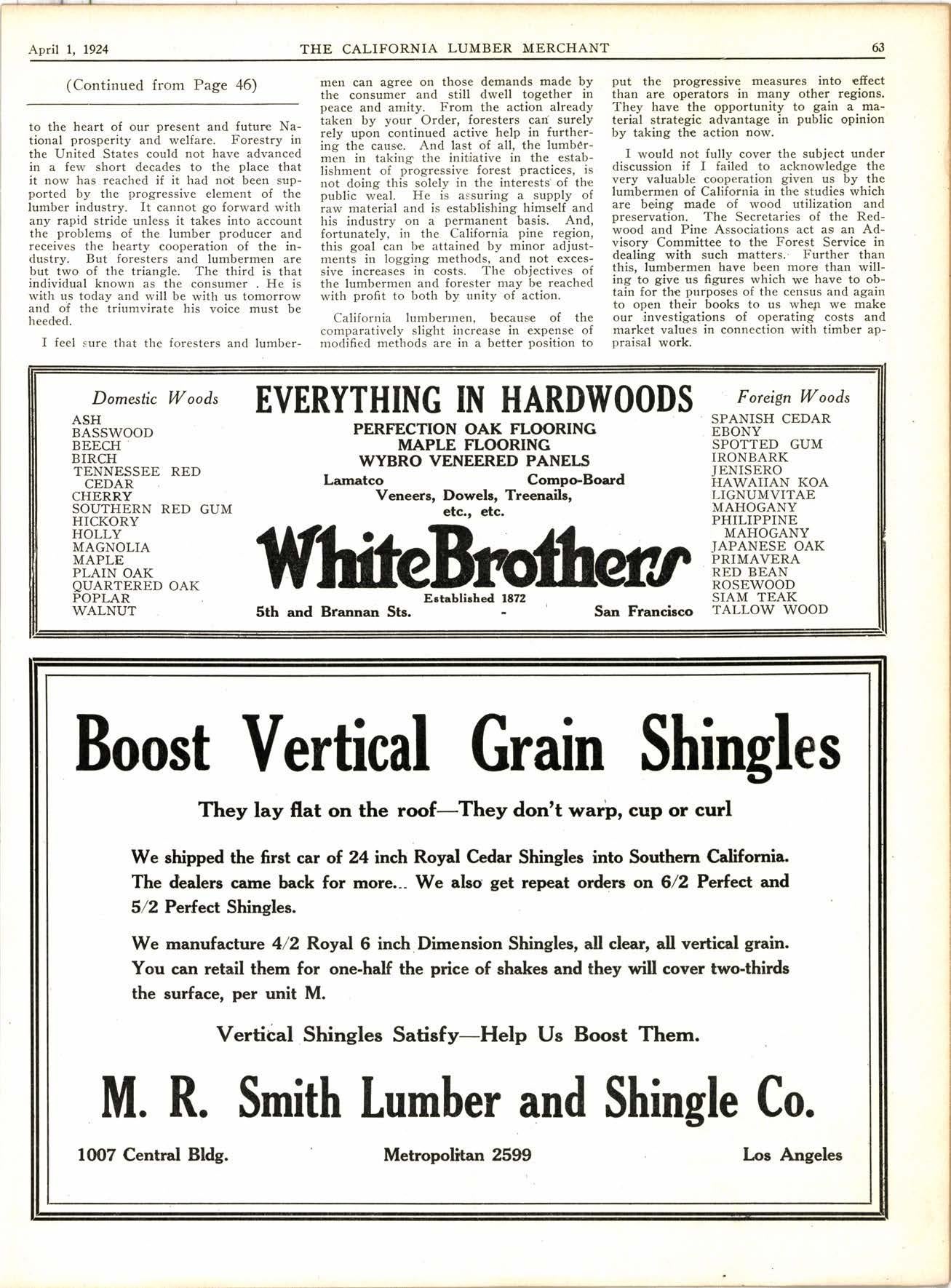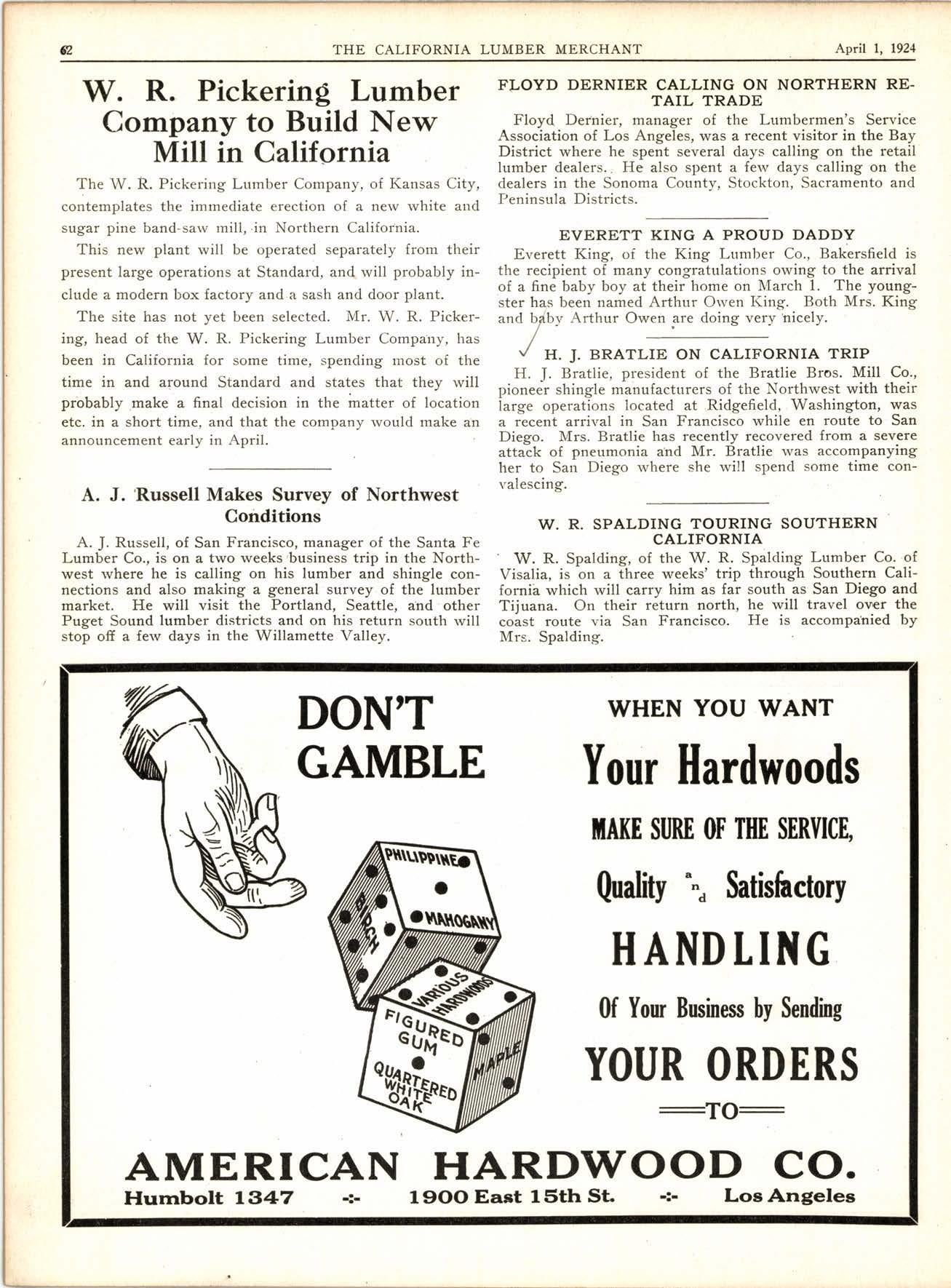
6 minute read
Cooperation With Lumbermen
An Address B-efore The Hoo-Hoo Club, San Francisco
By PAUL G. REDINGTON
I welcome the opportunity here given me to discuss our cooperative relations with the lumbermen of California. It gives me a chance, not only to talk about results already obtained through joint effort, but to point out the places where further coopera- tion between the lumberman and the forester is essential, viewed in the light of the interest which the consuming public has in obtaining a continuous and adequate sup- ply of wood products at a fair price.
Your organization, at its annual convention in New Orleans last September, registered in no uncertain manner its interest in the forest problem. Your Resolutions Committee report, read in part as follows:
"In regard to all of the items of the Snark's ieport upon the question.of forestry, the rvorking out of forestry on tracts of land in various parts of the United States, and the general encouragement of the forestry idia among the whole of the membership of Hoo-Hoo is highly approved, and we believe that ways and means should be arrived at for carrying it out fully."
I understand the reforestation resolution was unanimously adopted by the Convention. . This action was naturallv a most heartening one to all foresters, anl gives me an open avenue of approach to a <liscussion of the participation of lumbermen in the forest conservation movement.
It is necessary, first, to give a brief summary of the wood supply situation which confronts the Nation. then to consider the conditions in California, and follow with a discussion of such remedies as can be prac- tically applied to the ills diagnosed.
The National Situation
In quantity, but not in quality 42/o of. the original virgin stands of the country remains, a total of 2200 billion fe,et of timber. Although fu of. the true forest land of the Nation lies east of the Great Plains. this area only contains now 25,Vo of the uncut stumpage. The balance of the virgin supply is concentrlted, in fu of the acreage of timber-producing land in the States comprising the Rocky Mountain region and the Pacific Coast. About 469 million acres or 7a of the land surface of the United States is classified as forest or potenltial forest land. Of this, 138 million acres are virgin forest; 250 million acres have been cut over once or more, and now bear culled or second growth stumpage or small trees of no merchantable value, and 81 million acres are practically barren.
Approximately l0 million acres of forest land are cut over annually in the United SJtates, about one-half of which is virgin stumpage and one-half second growth woodland or areas previously culled. As far as data available permit striking a balance, it appears probable that the remaining saw timber. of softw^ood' species is disappearing approxrmately Er/2 times as fast as new growth is replacing it. Our hardwood tim- ber is being used up approxim&ely 3l/z trmes as fast as it is being replaced. It may be said that 25Vo oL the cuirent d.rain upon the national supply of wood is replaced by growth while 75Vo is an unreplacid de- pletion of the visible supply. Ii is fruitless to attempt any precise -estimate of the amount of wood which will be needed bv the United States in the future. Whateve-r assumption may be reached, the supolv ac- tually available wilt fall short of it ior a considerable period of years. The foreso- ing is quoted almost verbatim from the recent report of the Select Committee on Re_ forestation of the United States Senate, which, as you know, has spent much time during the last year in an exhaustive investigation of the N4tional situation.
The California Situation
We haye in California, according to the latest figures, a virgin supply of 284,505.000.000 ft. B. M. of which 2-3 is in pnivate'ownership, the balance being largily owned bv the Government in its National- Forests. Oi the privately owned stumpage, lll billion is owned by operators and holders in the oini region and 76 billion by the redwood ieo- ple. The future of the publicly-owned iim_
(Continued on Page 44)
(Continued from Page 43)' ber is secure. While we ar-e sllling annuall.r l"tc. amounts of National Forest.vtump- do so under such regulations as w-il[ insure the future productivity ot tne land, and we s€e to it that the amount.solc does not exceed the amount replaced Dy new growth' The future of the redwooo ilr.rti iitJ appearq bright inview. of the laree majority of the owners that lt ls gooc f"iin"iJ tot ihem to reforest their cutover f"nat. -htt" prospect is not so bright in r.esDect to the so-called pine regton ol Lallfornia. The growth of timber here is slowii ttti" in thE redwood region;-the menace of fire is also greater; the burden ot taxati,.; l; hiavv hJre as well and but verv few owners are -therefore showing any. concern for the future of their logged-off Iands on the ground that it is not good bustness' Obvi6usly, no one can e2(pect a man to soend money on unproductive - p-roperty' dn the othei hand, foresters and the consuming public have every right tg..9.xpecl that oDerators canvas every posslDlllty or o.r".coirins the obstacles which now stand in thC wav- of keeping cutover land prod-uci"s"L* irops of iimber.- Frankly, we fe.el that operators, even lnder ex$tlng conqri'io"t, do"ta do more than they have d-one in this direction. In the pine region ot Lalrfornia. nature will reforest the land providine sled tre€s are left and the cut-over "iEas are adequately protected from fire'
Much progress has been made in fire orotectiori of virein stands in the pine rehott. The Forest Service in 1910 instituted i fire orotection organization which has been oerfected until if now gives fairly adeouate Drot€ction to the timbered country. 'ihe private owners within and adjacent to the lfational Forests have realized that good business demands, the protec$on of their virgin timber from inroads by fire, and concluded that they could better aftord'to take advantage of the service of an established fire protection agency' operating on interlocking or adjacent lands, than to set up their own organization. Within and adijcent to the National Forests of the State, ire approximately 4% million acres of privateli owned timber land. 4 million acres of thls total is given protection by the Forest Service through cooperative agreements. The protection cost averages a little less than 2c per acre, and the land protected includes virgin stands and in some instances cut-over acres.
The cornpulsory fire patrol law endorsed bv the lumber industry and enacted last vlar bv our State legislature was a step rin [he riiht direction. - The lumbermen also have glven their support to the passage of special protective measures on logging areas, sb that-the danger of fires starting may be reduced to a minimum. Except as an incident to the protection of logging equipment and virgin timber, little attention or efiort has been devoted to preserving the voung growth of the otder cdtting areas. Irlatuially, the extent of these older cuttings is very huch greater than the land logged in any given year, and it is chiefly a matter of atcident whether or not this young wrowth, so necessary for future crops of tir:rber. will survive. Promiscuous, broadcast burning, even under the best of coniitions, is a practice which can not be tolerated under any system of forest lnanage- ment. A few progressive companies have recognized that it is cheaper to prtvent slash fires. than to suppress the occasional targe and costly conflagrations that inevitably occur and i'ause decrtase in log output and destruction of improvements, and have taken steps, in cooperation with the State forester-. to protect this young growth' As in the case of protection of virgin forests, reguation may be needed to secure Statewile application of an. adequate system of fire provention on cut-over lands. Sufficient justihcation for such regulations would appear to be furnished by the experience -ot ihe progress operators who have aiready instituted such systems
So much for fire protection. Important as it is, there are other problems to, be met to mailrtain tht productivity of California oine tirnber land. Seed trees are ,rec.sraiy. Foresteri, in studies, have shown tlrat the logging of ,srnalt trees between 12 'rnd. 20" in diaineter. is not good busiincss for the operator (1)-because of low grades of lumbei from such trees and (2)-cost of handling many pieces of small volume. If such t€es are left, they will serve as seed trees and form a good nucleus for a second crop of merchantable timber. Lumbermen havt not shou'n an inclination to act upon the facts brought out hy these studie-s but if the present destructive methods of logging on prirate land are continued, the tumberman will have few small trees to worry about. The desire for increased output has rcsulted in the introduction of destructive losging methods. Horse logging was sup- plinteii by small donkey engines pulling in logs by means of a cable traveling slowly on the gr.rurrrl. Delays were frequent because of stoppage of logs by obstacles during the handling process. To overcome this, the h,igh lead m€thod came into use, the'cable being held ofi the ground by a block fastened bn a sparttree 80 to 150 feet above the ground. Thus, at least foi a large porition of the haut, one end of a log is held 6fi the ground in order to avoid obstacles, and the-powerful machines haul in the log ina manner and at such a high rate of sp€ed that it sweeps down small trees and stands of reproduction.
(Continued on Page 46)
Catholic school erected in 1870 nozt being dk- nantleil for its sound Redwooil bmber.
It hes the permanent qualitiee of REDWOOD combined with lorr
IIIFTY-THREE yearE aso
.F built thie Catholic school California. lt is now being Redwood lumber it contains.










